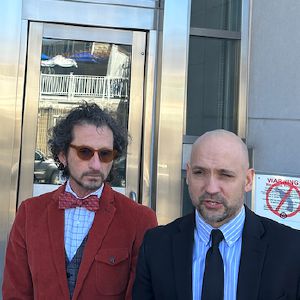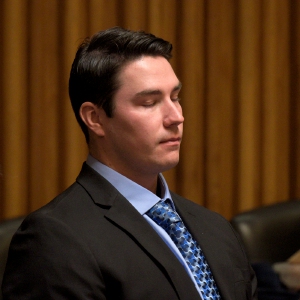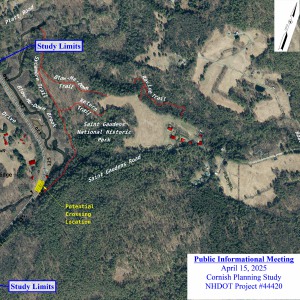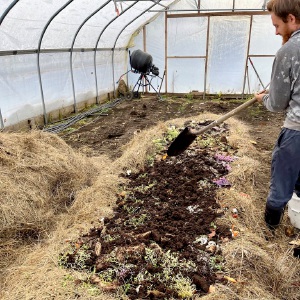Connecticut River Conservancy projects on hold due to federal funding freeze
| Published: 03-24-2025 4:03 PM |
WEST LEBANON — Water quality improvement and flooding mitigation projects along the Connecticut River and its tributaries are on hold due to a federal funding freeze.
Last November, the Connecticut River Conservancy was awarded an $11.5 million, five-year grant for a project titled “Improving Water Quality and Climate Resiliency in NH through Ecosystem Restoration” from the United States Department of Agriculture’s Regional Conservation Partnership Program.
The money came from the Inflation Reduction Act. But funding allocated through the act has been frozen through Executive Order 14154 “Unleashing American Energy” from the Trump administration on Jan. 21.
“It’s a huge amount of money that has potential to do so much for water quality and ecosystems in the entire Connecticut River Watershed,” said Marilla Harris-Vincent, a river steward for New Hampshire at the conservancy, a nonprofit organization that works on river-related projects in New Hampshire, Vermont, Massachusetts and Connecticut.
The river begins in Pittsburgh, N.H., and travels for more than 400 miles before emptying into the Long Island Sound.
The goal was to complete 15 projects over the course of the grant, including ones in Pittsburgh and Lancaster, N.H. Now there are fears that the summer work season — which typically runs from June through September — will be lost.
“Our construction seasons are so short in New Hampshire,” Lauren Zielinski, stream restoration specialist and Regional Conservation Partnership Program project manager at the conservancy, said. “We really take this time to get all of our projects lined up and designed and permitted and contracted. There are many things that go into the project before we break ground.”
The group has planned projects to put in riparian buffers, which involves planting trees, shrubs and other plants to filter water, which has an added benefit of slowing the flow of the river in extreme rain events.
Article continues after...
Yesterday's Most Read Articles
 Federal judge temporarily reinstates legal status for Dartmouth graduate student
Federal judge temporarily reinstates legal status for Dartmouth graduate student
 Prosecutors seek prison term of at least 30 years for man convicted at Dartmouth rape trial
Prosecutors seek prison term of at least 30 years for man convicted at Dartmouth rape trial
 Former Dartmouth ski team member dies in accident in California
Former Dartmouth ski team member dies in accident in California
 West Lebanon bridge reopens to vehicles
West Lebanon bridge reopens to vehicles
 Upper Valley donut maven Muriel Maville dies at 87
Upper Valley donut maven Muriel Maville dies at 87
Riparian buffers “also enhance habitat for sensitive species like brook trout, endangered dwarf wedge mussels and wood turtles,” Harris-Vincent said.
The grant also could be used for dam removals and culvert replacements.
“The great thing about this funding source is it’s five years. It allows us to react quickly to projects that come up,” said Zielinski.
The now-frozen funds were slated to support the organization to conduct outreach, engage with landowners, hire consultants and contractors, and implement restoration projects across the watershed, according to a news release from the conservancy.
“It’s a long process and there’s a lot of different players involved,” Harris-Vincent said. “You really can’t move forward if you don’t have any of the money to start this.”
While the initial projects in New Hampshire were planned miles from the Upper Valley, they could affect the way water flows downstream.
“Whenever you have a healthy stream up in the headwaters it means it’s better able to cope with the sudden heavy storms that were getting from climate change,” said Adair Mulligan, executive director of the Hanover Conservancy, a nonprofit organization that owns Lower Slade Brook Natural Area, part of which borders the Connecticut River.
The headwaters act as a “sponge” that helps absorb water and sediments.
“All of these things add up,” Mulligan said. “The more healthy stream miles we have, the healthier the river will be at the end of the day and the healthier the Long Island Sound will be.”
Riparian buffers help keep sediments in place, which can contains nutrients like nitrogen and phosphorus. An excess of those nutrients can lead to algae blooms, which can cause water quality to decline.
About 75% of the projects that the Connecticut River Conservancy does in New Hampshire are connected to federal funding, Zielinski said. The federal funding acts as leverage when soliciting other sources of revenue.
“Usually funders don’t want to be the only funder,” she said.
The conservancy also is waiting on the Natural Resources Conservation Service to approve its contract for construction funds for a separate Regional Conservation Partnership Program grant issued in 2021, Zielinski wrote in a follow up email.
There are three projects connected to that funding source scheduled for this summer, including one using natural materials to address erosion on Jacob’s Brook, a tributary of the Connecticut River in Orford, Zielinski said.
The Jacob’s Brook project, which will cost between $250,000 and $270,000, was scheduled to begin in August or September, according to meeting minutes from the Feb. 20 meeting of the Orford Conservation Commission. The plan calls for reinforcing part of the stream bank with native plants to slow soil erosion because “there is risk that flood waters could break through the current bank.”
Jacob’s Brook runs along Route 25A and the town offices are located on the state highway near the brook, Conservation Commission Chairman Bob Hedges said. In 2017, Jacob’s Brook flooded and damaged Route 25A.
“There was a lot of work that had to be done to repair that,” Hedges said.
He described the erosion work scheduled for Jacob’s Brook as a “big community benefit,” because it will help people who live along the brook and further downstream from the project site.
“It’s an expensive undertaking. It’s hard to imagine an individual person doing that,” Hedges said. “This kind of funding isn’t about academic research: it’s about, in our community, maintaining the property and making sure the stream banks are safe and making sure we’re ready for the next big rainstorm which we know will happen.”
While the three conservancy projects tied to the 2021 grant are shovel ready, the funding is paused due to a national review of government contracts.
“We have a little bit of wiggle room, but we work with local contractors and they need to schedule their summer projects,” Zielinski said. “Ideally we’d know by May if those projects are a go or not.”
Liz Sauchelli can be reached at esauchelli@vnews.com or 603-727-3221.






 NHDOT considers designated pedestrian crossings near Saint-Gaudens site
NHDOT considers designated pedestrian crossings near Saint-Gaudens site Orange County Republican finds his footing in Montpelier
Orange County Republican finds his footing in Montpelier  Local farms in New Hampshire are helping close loop on food waste
Local farms in New Hampshire are helping close loop on food waste Upper Valley businesses feel the sting of rising cocoa prices
Upper Valley businesses feel the sting of rising cocoa prices
